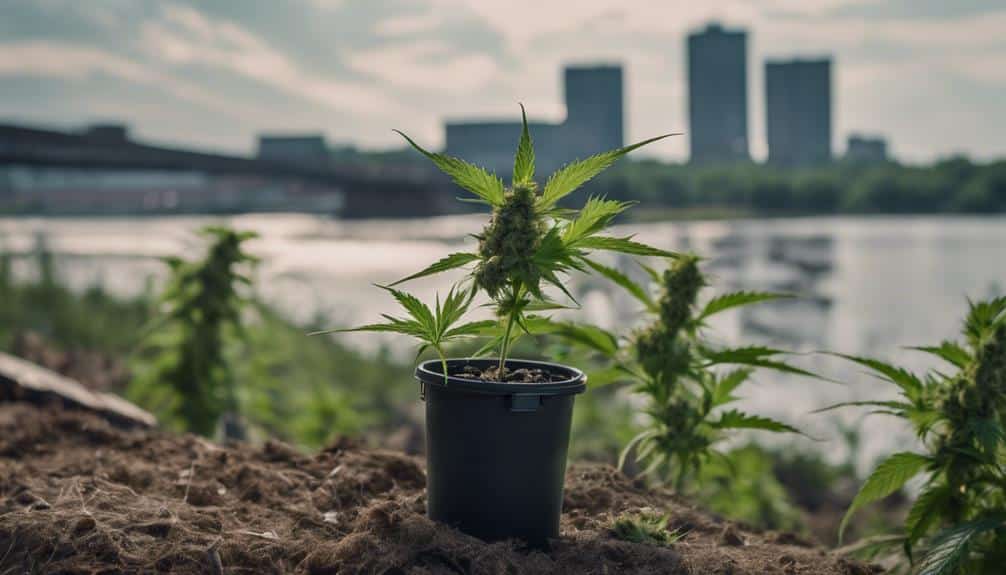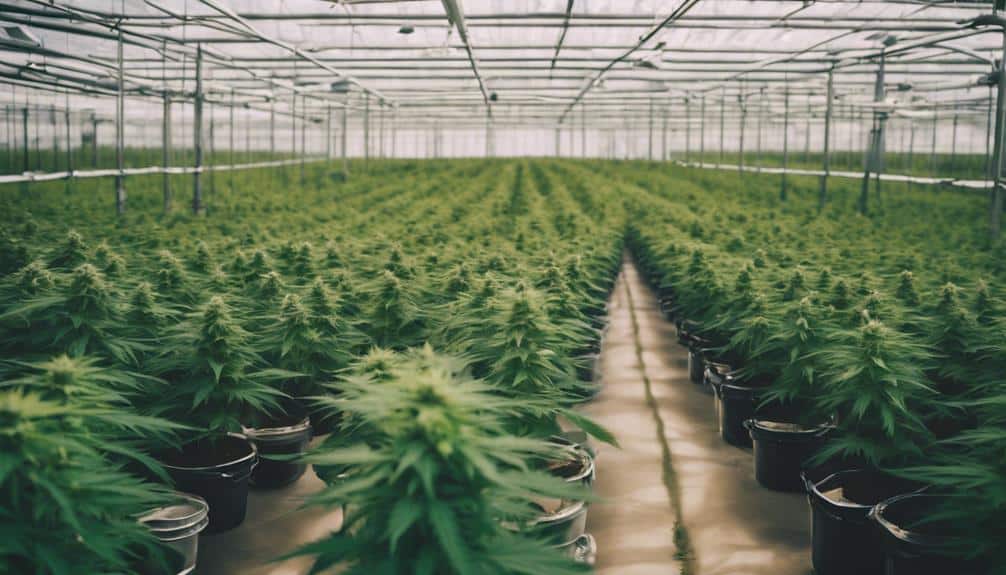Did you know that Maryland’s medical marijuana industry has a unique and significant environmental footprint? From energy-intensive indoor cultivation to water usage and waste generation, there’s much more to consider than you might think. The impact doesn’t stop there, though – the use of pesticides can also cause unforeseen repercussions. Interested in learning more about these effects and what can be done to mitigate them? There’s a wealth of information that needs to be unpacked.
Energy Usage in Cannabis Cultivation

In the heart of Maryland’s medical marijuana industry, the energy consumption in cannabis cultivation significantly contributes to its overall environmental footprint. The relationship between energy usage and cannabis cultivation is mainly characterized by lighting efficiency and the choice between indoor and outdoor cultivation.
Lighting efficiency is a major factor as indoor cultivation requires substantial artificial lighting. Energy-efficient lighting solutions can reduce energy consumption but are often overlooked due to higher upfront costs. However, investing in efficient lighting can lead to long-term energy savings and a reduced environmental impact.
The decision between indoor and outdoor cultivation significantly affects energy usage. Indoor cultivation provides a controlled environment but demands more energy due to the need for artificial lighting, temperature control, and ventilation systems. In contrast, outdoor cultivation relies on natural sunlight and climate, greatly minimizing energy use.
Understanding these dynamics equips you better for making decisions that reduce the environmental footprint of medical marijuana cultivation. Remember, efficient lighting and the choice of cultivation environment can greatly influence energy consumption. By prioritizing sustainability in these areas, you’re serving not only your industry but also our planet.
Water Consumption Patterns
Just as important as energy usage, the water consumption patterns in medical marijuana cultivation present another crucial aspect of the industry’s environmental impact. When growing these plants, it’s vital to use efficient irrigation techniques to reduce water wastage. These techniques involve delivering water directly to the plant’s root zone, thus minimizing evaporation and runoff.
However, not all water can be absorbed by the plants. Excess water often carries away nutrients and other essential substances. This is where water recycling comes into play. By recycling nutrient-rich water, you’re not only saving water but also reducing the need for additional fertilizers.
In Maryland, the medical marijuana industry is increasingly adopting such sustainable practices. Water recycling systems are becoming more prevalent and growers are continually looking for ways to improve their irrigation strategies. They’re using technology to monitor soil moisture levels and adjust watering schedules accordingly.
The emphasis on water conservation and recycling reflects the industry’s commitment to reducing its environmental footprint. As you strive to serve others through medical marijuana cultivation, remember that responsible water usage is key to sustainable growth. This isn’t just about saving resources; it’s about preserving the environment for future generations.
Waste Generation and Disposal

Beyond mindful water usage, it’s equally important to consider the waste generated by the medical marijuana industry and the methods employed for its disposal. As the industry expands in Maryland, the increase in waste production and consequent packaging pollution can’t be ignored.
- Packaging Pollution: The medical marijuana industry relies heavily on packaging to maintain product quality and meet regulatory requirements. However, most of this packaging is non-biodegradable, contributing significantly to landfill waste. As a result, it’s essential to explore sustainable packaging options that have less environmental impact.
- Composting Methods: Composting organic waste from marijuana cultivation can be an effective waste management strategy. It not only reduces the amount of waste reaching landfills but also enriches soil, promoting sustainable agriculture.
- Regulations and Compliance: State regulations need to mandate waste management practices that minimize environmental harm. Compliance with these regulations should be strictly enforced to ensure that the industry is moving towards sustainability.
You, as part of the community, can assist in advocating for environmentally friendly practices within the industry. Your actions can spur industry change and contribute to a healthier environment for everyone. Let’s work together to mitigate the environmental impact of Maryland’s medical marijuana industry.
Pesticides and Air Quality
Now let’s take a hard look at how pesticides used in the medical marijuana industry affect Maryland’s air quality. Pesticides are essential for crop protection but can contaminate soil which then degrades air quality over time as these chemicals evaporate into it.
When pesticides are applied incorrectly or excessively they leach into soil leading to contamination which affects not only soil health but also has potential harm on beneficial insects and organisms living within it. Furthermore as contaminated soil erodes pesticide particles become airborne leading potentially respiratory issues for those in surrounding areas.
The impact on worker health is another critical concern. Employees in the medical marijuana industry are often exposed to these pesticides and without proper precautions their health can be compromised. Long-term exposure to certain pesticides can lead to serious health issues including respiratory problems skin disorders and even certain types of cancer.
Thus while pesticides play a crucial role in the medical marijuana industry it’s evident that their use poses significant risks to Maryland’s air quality soil and worker health.
Mitigation Strategies and Sustainability

To mitigate these environmental risks, it’s essential to consider sustainable strategies for pesticide use in Maryland’s medical marijuana industry. Here, you can play a role in ensuring a greener future.
Let’s take a look at three key steps:
- Green Packaging: Opt for biodegradable or recyclable materials when packaging your products. This not only reduces waste but also bolsters your brand image as environmentally conscious.
- Carbon Footprinting: Strive to understand and minimize your carbon footprint. This includes tracking your energy use, waste production, and transportation methods then finding ways to reduce emissions in these areas.
- Organic Farming Practices: Encourage growers to use natural pest management and fertilizing methods that don’t harm the environment.
Conclusion
You’re part of the equation too. Your choices can help shape a greener future for Maryland’s medical marijuana industry. Opt for brands that prioritize sustainable practices, from energy-efficient cultivation to water recycling and waste reduction. Be mindful of pesticide use and its impact on our air quality. Together, we can turn the tide and ensure this industry not only heals people but also our planet. It’s not just coincidence, it’s our collective responsibility.
And hey, if you’re interested in learning more about this green revolution, why not pay us a visit at Fells Point Cannabis Docs of Maryland? We’re always here to answer any questions you might have and guide you through the process. So don’t hesitate to give us a call or stop by. We’re excited to meet you and discuss how together we can make a difference. It’s all about creating a sustainable future, and we’d love for you to be part of it.
